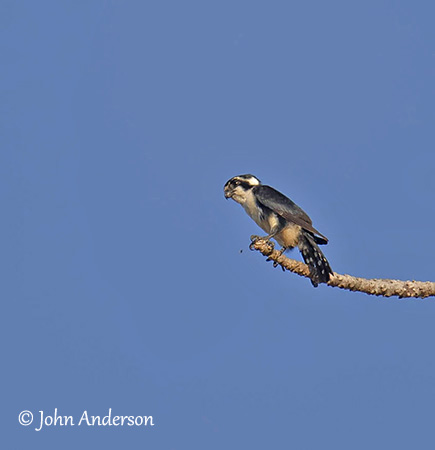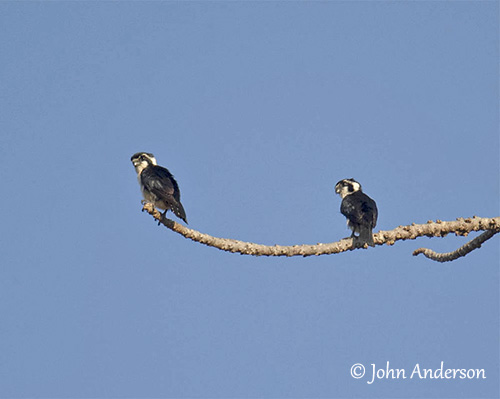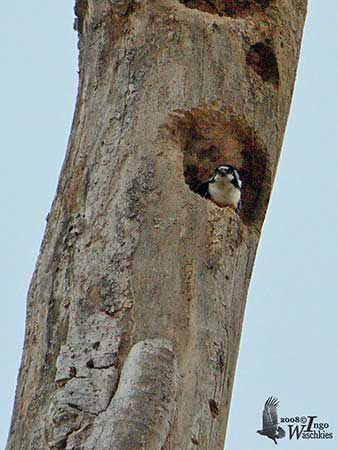
The female lays 4-5 white eggs, or sometimes only two. The nest hole is used all year round for roosting. Incubation and nesting periods are unknown.
PROTECTION / THREATS / STATUS:
The Black-thighed Falconet is threatened by commercial logging and forest clearance for agriculture expansion. However, this species is tolerant to disturbed habitats and varied diet, and it is suspected to be able to adapt to new areas.
The population is estimated to number in the tens of thousands and seems to be stable.
The Black-thighed Falconet is not globally threatened and currently evaluated as Least Concern.
Fr: Fauconnet moineau
Ang: Black-thighed Falconet
All: Finkenfälkchen
Esp: Falconete Indonesio
Ita: Falchetto zampenere
Nd: Musvalk
Sd: svartbent pygméfalk
Photographers:
John Anderson
John Anderson Photo Galleries
Ingo Waschkies
Bird Photography
Text by Nicole Bouglouan
Sources:
HANDBOOK OF THE BIRDS OF THE WORLD Vol 2 by Josep del Hoyo-Andrew Elliot-Jordi Sargatal - Lynx Edicions - ISBN: 8487334156
A Field Guide to the Birds of South-East Asia by Craig Robson. New Holland Publishers. ISBN: 9781780090498
RAPTORS OF THE WORLD by James Ferguson-Lees et David Christie - Helm Identification Guides – ISBN: 0713680261
Birds of Java, Sumatra and Bali De Tony Tilford – Editeur: Bloomsbury Publishing, 2017 – ISBN: 147293816X, 9781472938169 – 144 pages
Singapore Birds Project - Black-thighed Falconet
Global Raptor Information Network - Working to Conserve Birds of Prey in nature
Wikipedia, the free encyclopaedia
Black-thighed Falconet
Microhierax fringillarius
Falconiformes Order – Falconidae Family
INTRODUCTION:
The Black-thighed Falconet is one of the smallest birds of prey, similar in size to the House Sparrow. This small Falconidae is found in Myanmar, Thailand, Malaysia, Sumatra, Borneo, Java and Bali.
It frequents forest, forest edges and clearings, and is usually present below 1,200 metres of elevation. It feeds mainly on large insects and small birds, but larger birds are sometimes caught too. It nests in cavities, often in abandoned nests in trees or holes in limestone cliffs.
The Black-thighed Falconet is described as common to fairly common. It is able to adapt to disturbed habitats, and the species is not globally threatened for the moment.
DESCRIPTION OF THE BIRD:
Biometrics:
Length: 14-16 cm
Wingspan: 27-34 cm
Weight: 28-55 g
The Black-thighed Falconet adult male is very similar to the Collared Falconet.
The upperparts are glossy black, without white nuchal collar. Tail and secondaries show white spotting.
On the underparts, the throat is white or washed rufous. The breast is white, shading into the rufous belly. Flanks and outer thighs are black. The undertail is barred black and white.
On the head, crown and nape are glossy black. The forehead is white and we can see a narrow, white supercilium. Sides of face and ear-coverts are black.
Bill and cere are black. The eyes are dark brown. Legs and feet are black.

The adult female has similar plumage, but she is larger than male, with longer tail.
Both adults have square-ended tail and pointed wings.
The juvenile resembles adult, but the pale areas of the head are washed rufous. On the upperparts, the feathers are fringed rufous.
RANGE:
The Black-thighed Falconet is native to Brunei Darussalam on Borneo, Myanmar, Thailand, Malaysia, Singapore (where it is scarce) and Indonesia.
The species is resident on Greater Sundaes, but it is generally resident throughout the range.
HABITAT:
The Black-thighed Falconet typically frequents forest, forest edges and clearings, but it is also found near cultivated areas, villages and disturbed habitats such as slash-and-burn forest clearance. It is often near rivers and streams, and may sometimes hunt over paddyfields.
The species is found from sea-level up to 1,500 metres of elevation in Sumatra, but more frequently below 1,200 metres.
CALLS AND SONGS: SOUNDS BY XENO-CANTO
The Black-thighed Falconet gives a shrill, squealing “kweer”, but we can also hear a fast-repeated “kli-kli-kli-kli” or “killi-killi-killi”.
BEHAVIOUR IN THE WILD:
The Black-thighed Falconet feeds primarily on large insects such as moths, butterflies, dragonflies, orthopterans and coleopterans. It also catches small birds to size of warblers or pipits, and occasionally small reptiles and mammals.
From an observation, this small raptor is also able to kill larger birds such as babbler (here a Black-capped Babbler - Pellorneum capistratum) weighing about 28 grams. The falconet was observed carrying the prey by flying laboriously to three low perches in succession, before reaching its main perch on a dead tree where the prey was eaten.
The Black-thighed Falconet usually hunts from perch with good view. Its dashes out to chase and catch some passing insect in flight, but it also plucks prey from flowers and foliage, rarely from the ground. It usually returns to the same perch or sometimes a different one. It may also hawk and eat small insects on the wing. The moths are mainly taken at dusk, often near artificial lights.
The Black-thighed Falconet may hunt in small groups of ten individuals perched on adjacent perches. They perform sallies like flycatchers. They hunt from exposed perches above forest canopy or at forest edge and along rivers. The prey is usually caught after swift, powerful flight.

This species nests and roosts in tree holes, often abandoned barbet or woodpecker holes. The courtship displays include mutual preening during about 30 minutes. Aerial displays are not recorded.
The Black-thighed Falconet is sedentary in its range.
The flight is fast and powerful with rapid wingbeats interspersed with long glides. It sometimes twists and turns while pursuing a prey, before gliding back to the perch.
REPRODUCTION OF THIS SPECIES:
The breeding season takes place between February and May, but it may vary depending on the range.
The Black-thighed Falconet nests in abandoned holes, between 6 and 20 metres above the ground. No material is added. The hole is often in dead tree, but sometimes in building, or in cavity in limestone cliff in Malaysia.
